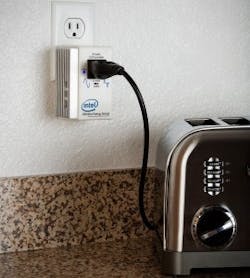Enter the Flexiwatt: A New Choice for Consumers and a Business Opportunity for Green Tech Innovators
Credit: Intel Free Press
Most homeowners probably think they have three choices when it comes to electricity. Buy it from a power provider, generate it themselves, or avert its use altogether through energy efficiency.
But the Rocky Mountain Institute has put forward a fourth choice. The flexiwatt.
Not really new in practice, but certainly in name, the flexiwatt gives identity to the idea of controlling energy use in the home through load shifting with advanced energy technologies.
Smart thermostats and appliances, coupled with time-varying rates, give consumers the flexibility to avoid use of electric power during a pricey time of day. These smart energy devices shift use to a period when power is cheaper. Perhaps clothes get dried or electric vehicles charged at night when electricity rates drop.
Basically, work gets done around the house using the flexiwatt instead of the conventional kilowatt.
Market Scope
The Rocky Mountain Institute not only gives name to this practice, but also defines the flexiwatt’s market size and capability in its new report, “The Economics of Demand Flexibility: How ‘Flexiwatts’ Create Quantifiable Value for Customers and the Grid.”
By shifting use of energy to lower-cost periods, consumers take pressure off the grid when it’s under strain. Given that these periods of peak demand are growing, they are used to justify construction of new power plants and transmission lines. In fact, the U.S. Department of Energy estimates need for a $1–1.5 trillion of grid investment in the next 15 years, including $505 billion for power plants, $300 billion in transmission, and more than $580 billion for distribution.
Easing peak demand reduces the need — and cost — to build a big chunk of this new infrastructure.
“Utilities can potentially avoid $13 billion per year in forecasted grid investment needs by just making simple residential loads flexible and responsive to price signals,” said James Mandel, a principal in RMI’s electricity practice and coauthor of the report. “With a projected $50 to $80 billion of investment needed annually for the grid in the next 15 years, demand flexibility takes a big bite out of those numbers.”
For consumers, flexible demand can lead to savings of 10 to 40 percent on utility bills.
To calculate potential savings, the organization applied the concept to rate structures at four U.S. utilities — Commonwealth Edison, Salt River Project, Hawaiian Electric Co. and Albama Power. RMI found energy savings potential of $110 to $250 million per year in each of the four utility territories analyzed.
“The total nationwide market is even bigger than our four analyzed scenarios,” said Mark Dyson, another coauthor of the report.
Why Now for Flexiwatt
RMI sees the time as ripe for demand flexibility in part because of emerging local energy business models. Home energy management system providers, renewable energy installers, demand response companies, and appliance manufacturers, are among those well-positioned to package the flexiwatt, possibily with other products that have strong consumer appeal, such as rooftop solar and home energy management systems.
One cavaet: the flexiwatt concept requires that utilities offer consumers time-sensitive rates — those that align at least somewhat with the changing cost of wholesale power. About 65 million households have access to such rates, and only 4 million households participate. That’s three percent of U.S. residential customers.
Homeowner numbers are likely to grow as more utilities offer time-varying rates and the rates more closely allign with real costs. (Load shifting is already used extensively among factories and other businesses that are large energy users.)
Appliance manufacturers also can help spur the concept by imbedding load-shifting capability in more products, RMI said.
But to really move the flexiwatt market forward, three key stakeholders need to work together: private innovators, utilities and regulators, according to RMI.
Private innovators already have the technology and business model ideas to capture the value of flexiwatts, but are limited by a lack of granular rates or local market participation options from utilities.
Utilities, in turn, are hesitant to introduce time-sensitive rates unless they believe regulatory support exists. Meanwhile, regulators want to see demonstration projets that show flexiwatts in action.
“The ability to capture the value of flexiwatts at scale will ultimately rely on the success of integrated efforts to find win-win value propositions for customers, utilities, and third-party service providers alike,” the report said.
The RMI report is available here.
Any ideas for business models that incorporate the flexiwatt? Post your thoughts below or on our LinkedIn Group, Energy Efficiency Markets.
About the Author
Elisa Wood
Editor-in-Chief
Elisa Wood is the editor and founder of EnergyChangemakers.com. She is co-founder and former editor of Microgrid Knowledge.
